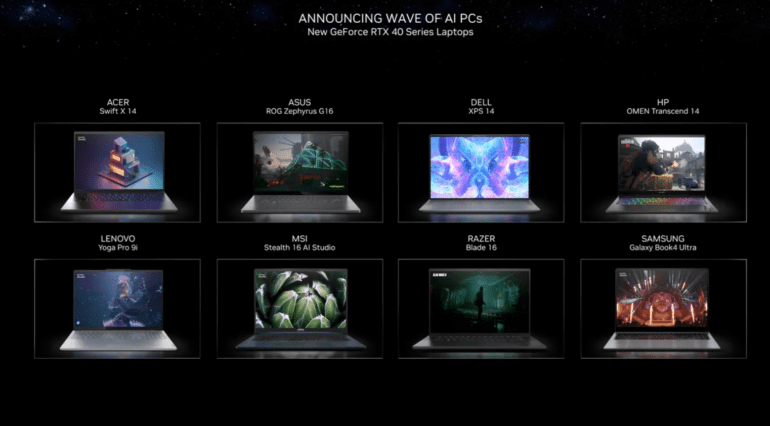TL;DR:
- Nvidia unveils a range of products at CES 2024, including AI-driven laptops and graphics cards.
- The company emphasizes the role of personal computers in harnessing large language models and generative AI.
- New RTX 40 Super series graphics cards promise 1.7 times faster video and 1.5 times faster image generation.
- Leading PC manufacturers like Acer, ASUS, and Dell are introducing “AI-ready” laptops equipped with Nvidia’s RTX cards.
- Nvidia’s AI Workbench software enables programmers to utilize language models and cloud computing for enhanced capabilities.
- In-game avatars receive an upgrade with automatic speech generation and facial animations.
- Getty Images introduces “Generative AI by iStock” using Nvidia’s technology.
- Nvidia expands its presence in the automotive market with Li Auto, GWM, and Xiaomi adopting its technologies.
- Mercedes-Benz showcases its “Concept CLA Class” using Nvidia’s DRIVE Orin chip platform.
Main AI News:
Nvidia, a prominent player in the tech industry, has taken center stage at the Consumer Electronics Show (CES) this year with a bold vision for the future of computing. The company’s Senior Director of Product Management, Justin Walker, addressed reporters, setting the tone for the event: “The big buzz at CES this year is gonna be all about generative AI and AI PCs.”
In the realm of consumer AI, Nvidia is championing the personal computer as a robust platform for unleashing the power of “large language models,” including Meta’s Llama 2 and the widely acclaimed Stable Diffusion image program. To support this endeavor, Nvidia has unveiled the RTX 40 Super series of graphics cards, promising video and image generation speeds that are 1.7 and 1.5 times faster, respectively.
What makes this announcement even more exciting is the collaboration with leading PC manufacturers, including Acer, ASUS, Dell, HP, Lenovo, MSI, Razer, and Samsung. These manufacturers are gearing up to launch “AI-ready” laptops equipped with Nvidia’s cutting-edge RTX cards, all set to hit the market this month. The workstation cards, comprising three models – 4070 SUPER, 4070i SUPER, and 4080 SUPER – are priced at $599, $799, and $999, respectively.
Nvidia is building on its previous release of TensorRT-LLM for Windows, emphasizing the personal computer’s role as a training hub for large language models in tandem with cloud services. The forthcoming AI Workbench software for PCs, set to launch as a beta release, empowers programmers to access language models from repositories like Hugging Face and leverage cloud computing facilities, such as Nvidia’s DGX Cloud. The RTX cards can then be harnessed for “inference and light customization.”
Furthermore, Nvidia is making significant strides in the consumer market by enhancing in-game avatars with automatically generated speech. Through their ACE (avatar cloud engine) initiative, the company enables game developers to integrate Nvidia’s speech recognition and facial animation programs into their games. This groundbreaking technology allows players to engage in natural conversations with in-game characters, thanks to automatic speech recognition and large language models that generate dynamic responses. These responses are then vocalized and synchronized with facial animations using sophisticated AI models.
In another intriguing development for consumers, Getty Images has introduced “Generative AI by iStock,” a service built using Nvidia’s “Picasso” program. This service empowers users to create stunning 4K imagery from text, drawing from an AI model trained on Getty Images’ extensive catalog of licensed creative content. It’s a transformative tool that’s available immediately at istock.com.
Beyond consumer-centric innovations, Nvidia is making waves in the automotive industry. Li Auto, an electric vehicle manufacturer, is set to employ Nvidia’s “Drive Thor” computer platform, touted as a “centralized computer for safe and secure autonomous vehicles.” Additionally, GWM (Great Wall Motor) and Xiaomi have chosen Nvidia’s “DRIVE Orin” chips to enhance their ADAS (automated driver assistance systems).
Mercedes-Benz, a valued Nvidia customer, showcased its “Concept CLA Class” at the CES event, featuring Nvidia’s “DRIVE Orin” chip platform. What’s more, Mercedes-Benz is leveraging “digital twin” technology in its design process through Nvidia’s Omniverse software platform for virtual reality application development.
Conclusion:
Nvidia’s strong presence at CES 2024 marks a significant advancement in the AI and computing market. Their focus on AI-powered PCs, large language models, and collaboration with major PC manufacturers signals a growing trend toward AI-driven computing for consumers. The introduction of innovative tools for game avatars and image generation further underscores Nvidia’s commitment to AI integration across industries. Additionally, their partnerships in the automotive sector demonstrate the expanding applications of AI in autonomous vehicles. Overall, Nvidia’s showcase highlights the company’s pivotal role in shaping the future of AI technology.

